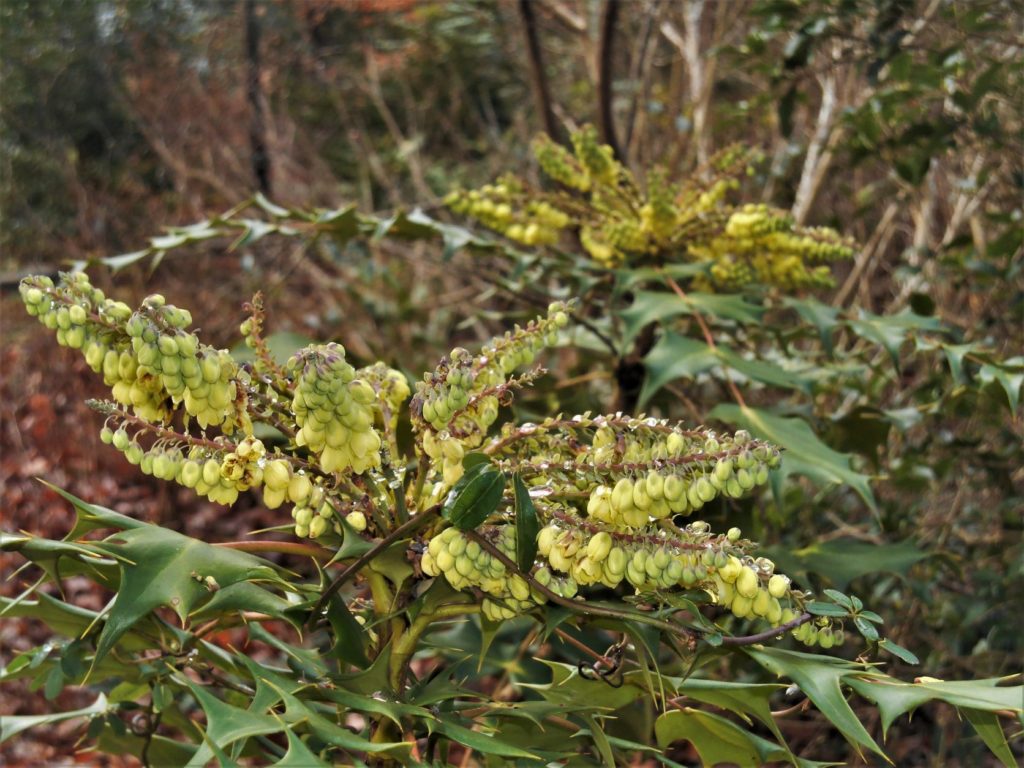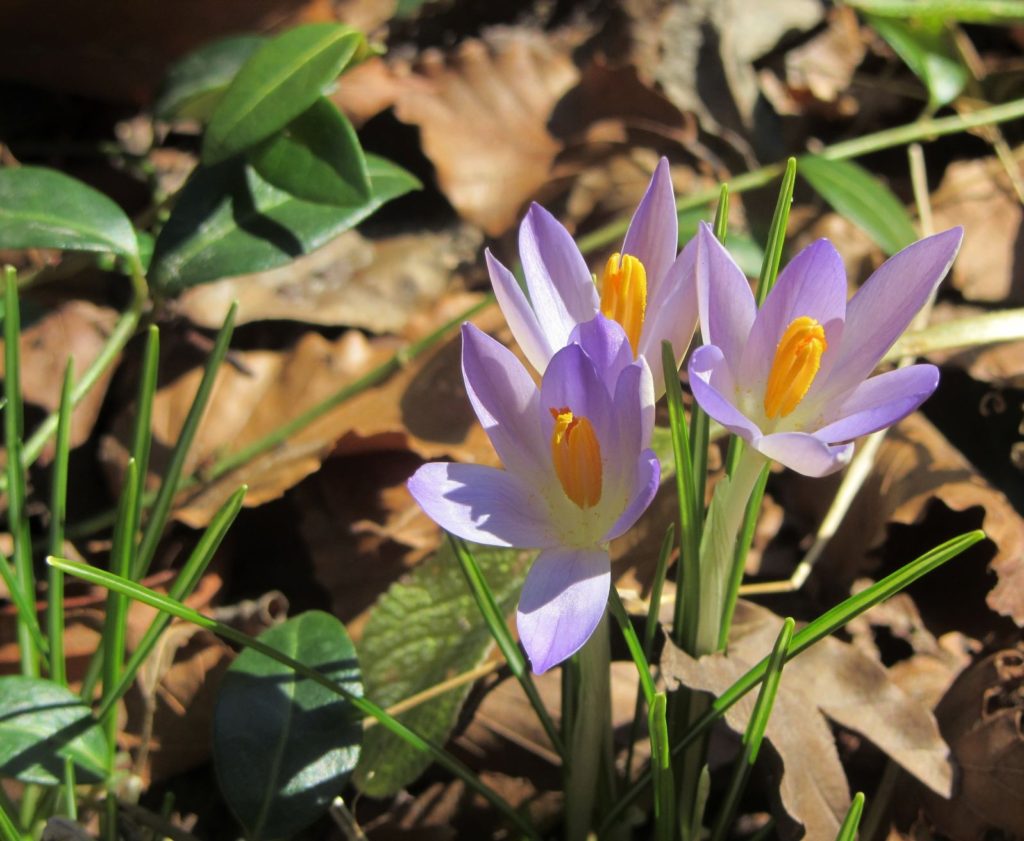Winter Flowers for Pollinators
Did you notice bees and other insects feeding later than usual last year? And did you notice how many were out feeding on warm days last winter? Our roller coaster weather affects insects, birds and other animals. They may be out and about on warmish days in months when we don’t expect to see them. And, of course they are hungry!
Increased activity translates into an increased need for calories. Providing winter forage for pollinators and birds presents gardeners with an interesting challenge. It brings us round again to that ongoing discussion of ‘native’ vs. imported plants. I could argue either side of this issue, and have.
But consider that few of our indigenous native plants bloom between November and February in this climate. Most of our familiar winter blooming flowers are native to areas of Europe, the Mediterranean region, South Africa, or Asia. Even though the plants may have originated on another continent, they fill an important ecological niche by offering nectar and pollen, sustaining native bees and other insects who might otherwise starve when they venture out on warming winter days.

Mahonia aquifolium, now Berberis aquifolium, is native to the Pacific Northwest. It has naturalized in our region and supports both pollinating insects and birds. It is usually blooming in December and January.
Now a native plant advocate could offer the counter argument that many imported plants have adapted so well to our climate, and naturalized so freely, that they sometimes crowd out our indigenous native species. I could list several woody invasive species that bloom in winter or early spring that we should avoid planting. While we argue the fine points of the question, developers are busy clear cutting our local forests to widen the roads and plant new neighborhoods and shopping strips where native species once grew.
Let’s agree to plant consciously and with purpose, to sustain the wildlife we have left, absorb as much carbon as possible from the warming air, and to create spots of beauty to cheer and inspire us. You will find a wide variety of spring flowering bulbs, shrubs and trees for sale right now. This is the best season for planting new woody plants in our region.
Fall-planted spring blooming flowers from bulbs provide an important source of sustenance for many insects. Each bulb may produce multiple flower stalks. They form offsets, clump and reseed to gradually naturalize. Most grow well under deciduous trees and appreciate dry shade in summer.
The earliest flowers each winter may be snowdrops, Galanthus species. Scilla siberica, another European bulb, often pops up and begins blooming in February. Its stalk can be covered with many small flowers, opening a few at a time over a period of weeks. The leaves follow the flower stalk and fade away again by early summer. Scilla bloom alongside early Iris histrioides and early Crocus bulbs, also appreciated by hungry pollinators in late winter.
If you plant Crocus, choose C. tommasinianus to thwart squirrels and other rodents, who search out and feed on other Crocus species bulbs. The ‘Tommies’ are some of the earliest of the Crocus to bloom and thrive in partial shade. Give new bulbs a spray of repellent, such as Plantskydd or Repells-All, before planting them, for some protection from rodents.
Other very early blooming flowers from bulbs include Muscari, Chionodoxa or glory of the snow, and early Narcissus. These are all low growing, ephemeral plants that will disappear by early summer.
Helleborus species and hybrids remain a mainstay of our garden both for their bright winter flowers and for their evergreen foliage that serves as a sturdy and effective ground cover year-round. Requiring very little maintenance beyond removing old and tattered leaves from time to time, these tough, long-lived plants reliably bloom and feed pollinators from December through late April. The flowers offer plenty of pollen as well as deep reservoirs of nectar. Each flower may last several weeks, feeding insects over a long period, and then producing seeds.
Nothing grazes a Hellebore because all parts of the plant are poisonous. The more Hellebores we grow the less we find tunnels made by voles or moles. Their large, glossy leaves remain attractive for many months, often sporting variegation, toothed edges, and interesting form. They provide cool, moist habitat for small animals, and hold the soil of our sloping garden. Hellebores prefer full to partial shade and mix well with ferns and other ground covers.
For sunny areas, consider planting the common Mediterranean evergreen herbs rosemary and thyme in Zones 7 and south. Rosemary often blooms with tiny blue or white flowers from November through April, and thyme usually begins to bloom by March. Both are highly attractive to bees and other pollinators.
Violas bloom from fall planting until it grows too hot for them here in early summer. Native to mountainous areas of Europe, colorful little Viola cornuta have been cultivated and hybridized over decades and are easily available each fall in our area. You may know some of them as ‘Johnny Jump-Ups.’ They may be grown from seeds or plugs, or bought larger pots for instant color in fall and winter arrangements. Although Violas are perennials, they don’t survive our summer heat.
The larger Viola tricolor, or pansy, is also native to Europe and has been bred for flower size and color. Panolas are a fairly recent cross between various Viola species. They offer a medium sized flower with beautiful color and form. The plants are lush and offer the impact of a pansy with the hardy habit of a Viola cornuta. Pansies and Panolas bloom in late fall and early spring, but they may take a break during the coldest months.
One of my favorite winter blooming shrubs remains the Mahonia aquifolium, now Berberis aquifolium, which is a North American native shrub that has naturalized in Virginia. There are several species, hybrids and cultivars of Mahonia, and they bloom extravagantly in December through February each year, with plump, edible drupes forming by early summer. Oregon Grape Holly offers shelter and food for birds, nectar for pollinating insects, and has such stiff, sharp leaves that deer and other herbivores don’t graze its leaves. If you plant some of the finer leaf varieties, like ‘M. Soft Caress,’ be prepared for deer to find and sample it. It is a lovely plant if you can protect it.
One of the best indigenous native shrubs for winter flowers is the witch hazel, or Hamamelis virginiana. It covers itself in small, sweet blossoms in mid to late winter. Some native Vaccinium species, like the early blueberry, bloom as early as February. Pollinators also appreciate Japanese Pieris; Japanese quince, Chaenomeles japonica; Chinese Edgeworthia and Camellias.
Camellia sasanqua begins blooming in October and continues producing flowers into January, in the Williamsburg area. Camellia japonica begins blooming in December or January. The more open flowers of these Asian shrubs prove easier for pollinators to access than the fully double flowers.
Finally, many trees bloom in the winter and early spring. Though their flowers may seem insignificant to us, they provide important food sources for pollinators. Birds also benefit when they feed on insects attracted to arboreal flowers.
We may not even notice some trees’ flowers because they are so tiny. We may catch a sweet fragrance from an Ilex or Osmanthus, or notice an attractive blur of red or gold around a maple tree’s canopy before its leaves unfold. But these flowers are very important to wildlife.
Redbud trees, Cercis canadensis, begin to bloom by February, becoming magnets for hungry insects. Several species of Spirea, Prunus and Viburnum produce early, showy nectar filled flowers in February and March. They attract many insects and birds as they fill the early spring garden with color.
No one small, residential garden can support all plants for all purposes. But with a bit of thought and planning, we can all provide some seasonal support for wildlife Planting winter blooming woody plants and herbaceous perennials supports the web of life in our garden and the wider community. We can enjoy the beauty and activity winter bloomers add to our own gardens at an otherwise bleak time of the year.
All photos by Elizabeth McCoy
Elizabeth McCoy is a JCCW Master Gardener, class of 2018, a Tree Steward and former Williamsburg Botanical Garden volunteer.











